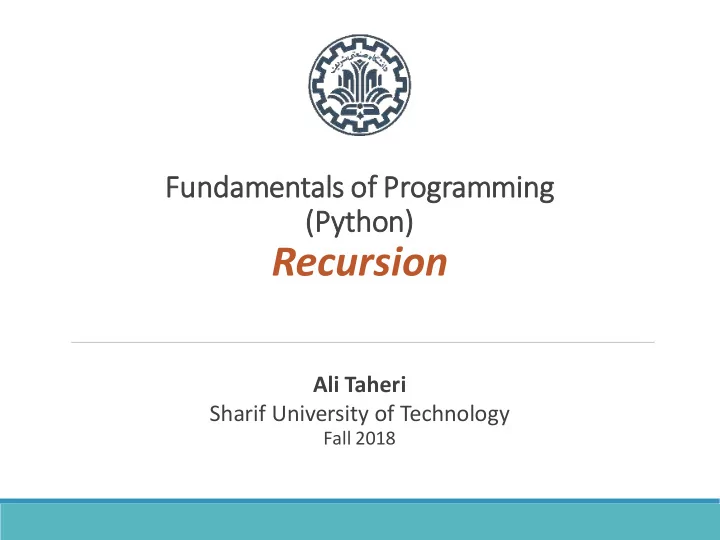

Fu Fundamentals of Pr Programming (Py Python) Recursion Ali Taheri Sharif University of Technology Fall 2018
Outline 1. Recursive Functions 2. Example: Fibonacci 3. Memoization 4. Example: Binomial Coefficient 5. Example: Towers of Hanoi 6. Example: Fast Exponentiation 2 Fall 2018 ALI TAHERI - FUNDAMENTALS OF PROGRAMMING [PYTHON]
Recursive Function A function which calls itself is referred to as a Recursive function ◦ Example: the factorial function 𝑜! = 𝑜 ∗ 𝑜 − 1 ! 𝑗𝑔 𝑜 > 0 1 𝑝𝑢ℎ𝑓𝑠𝑥ℎ𝑗𝑡𝑓 A recursive function always consists of two parts ◦ Base Case: one or more cases for which no recursion is applied ◦ Recursive Step: all chains of recursion eventually end up in one of the base cases The concept is very similar to mathematical induction 3 Fall 2018 ALI TAHERI - FUNDAMENTALS OF PROGRAMMING [PYTHON]
Example: Fibonacci The Fibonacci sequence: ◦ 0,1,1,2,3,5,8,13,21,34,55,89,134 0 𝑗𝑔 𝑜 = 0 1 𝑗𝑔 𝑜 = 1 𝐺𝑗𝑐 𝑜 = 𝐺𝑗𝑐 𝑜 − 1 + 𝐺𝑗𝑐 𝑜 − 2 𝑝𝑢ℎ𝑓𝑠𝑥𝑗𝑡𝑓 def fib(n): if n == 0: # Base Case return 0 if n == 1: # Base Case return 1 return fib(n-1) + fib(n-2) # Recursion Step 4 Fall 2018 ALI TAHERI - FUNDAMENTALS OF PROGRAMMING [PYTHON]
Example: Binomial Coefficient The binomial coefficient counts the number of ways to select 𝑙 items out of 𝑜 : 𝑜 𝑙 − 1 + 𝑜 − 1 𝑜 𝑙 = 𝑙 − 1 0 = 𝑜 𝑜 𝑜 = 1 def bin(n,k): if k == 0 or k == n: # Base Cases return 1 return bin(n-1,k) + bin(n-1,k-1) # Recursion Step 5 Fall 2018 ALI TAHERI - FUNDAMENTALS OF PROGRAMMING [PYTHON]
Example: Towers of Hanoi An elegant application of recursion is to the Towers of Hanoi problem: ◦ There are three pegs and a pyramid-shaped stack of 𝑜 disks ◦ The goal is to move all disks from the source peg into the target peg with the help of the third peg under some constraints 6 Fall 2018 ALI TAHERI - FUNDAMENTALS OF PROGRAMMING [PYTHON]
Example: Towers of Hanoi Constraints: ◦ Only one disk may be moved at a time ◦ A disk may not be “set aside”. It may only be stacked on one of the three pegs ◦ A larger disk may never be placed on top of a smaller one. 7 Fall 2018 ALI TAHERI - FUNDAMENTALS OF PROGRAMMING [PYTHON]
Example: Towers of Hanoi def hanoi(n, source, target, third): if n == 1: # Base case (we have only one disk) print( 'Moving disk %d from %s to %s' % (n, source, target)) else : # Recursive Step # Move n-1 disk from source to third hanoi(n - 1, source, third, target) # Move nth disk from source to target print( 'Moving disk %d from %s to %s' % (n, source, target)) # Move n-1 disk from third to target hanoi(n - 1, third, target, source) 8 Fall 2018 ALI TAHERI - FUNDAMENTALS OF PROGRAMMING [PYTHON]
Some Problems Problem #1 Assume a table 𝑈 having following value in cell (𝑗, 𝑘) : 𝑘 𝑗 = 1 𝑘 𝑈(𝑗, 𝑘) = 𝑈(𝑗 − 1, 𝑙) 𝑗 > 1 𝑙=1 Write a function to calculate 𝑈(𝑗, 𝑘) recursively. Problem #2 We have a game board having ∞ rows and 𝑂 columns. Having a marble in row 1 and column 𝑑 (cell (1, 𝑑) ). In each phase, we can move the marble to the next row of current column or one of the columns beside. Write a recursive function to compute the number of ways we can move the marble to cell (𝑗, 𝑘) . 9 Fall 2018 ALI TAHERI - FUNDAMENTALS OF PROGRAMMING [PYTHON]
Memoization Recursive step often computes similar results multiple times which is inefficient We can save partial results for further use ◦ This technique is called memoization memo = {} # Partial results def fib(n): if n == 0: # Base Case return 0 if n == 1: # Base Case return 1 if n in memo: # Return the result if return memo[n] # it has already computed memo[n] = fib(n-1) + fib(n-2) # Save the result return memo[n] 10 Fall 2018 ALI TAHERI - FUNDAMENTALS OF PROGRAMMING [PYTHON]
Example: Fast Exponentiation Given a matrix 𝐵 , we want to calculate 𝐵 𝑜 ◦ Suppose we have written a function mat_prod to calculate the product of two matrices ◦ We can use mat_prod 𝑜 times to calculate 𝐵 𝑜 , but it is inefficient for large 𝑜 ◦ Divide and conquer technique can lead to a more efficient solution 𝐵 𝑜/2 × 𝐵 𝑜/2 𝑗𝑔 𝑜 𝑗𝑡 𝑓𝑤𝑓𝑜 𝐵 𝑜 = 𝐵 𝑜/2 × 𝐵 𝑜/2 × 𝐵 𝑗𝑔 𝑜 𝑗𝑡 𝑝𝑒𝑒 𝐽 𝑗𝑔 𝑜 = 0 11 Fall 2018 ALI TAHERI - FUNDAMENTALS OF PROGRAMMING [PYTHON]
Example: Fast Exponentiation def exp(A, n): if n == 0: # Base Case return [[1, 0], [0, 1]] temp = exp(A, n // 2) # A**(n/2) prod = mat_prod(temp, temp) # A**n if n % 2 == 0: return prod else : return mat_prod(prod, A) 12 Fall 2018 ALI TAHERI - FUNDAMENTALS OF PROGRAMMING [PYTHON]
Recommend
More recommend